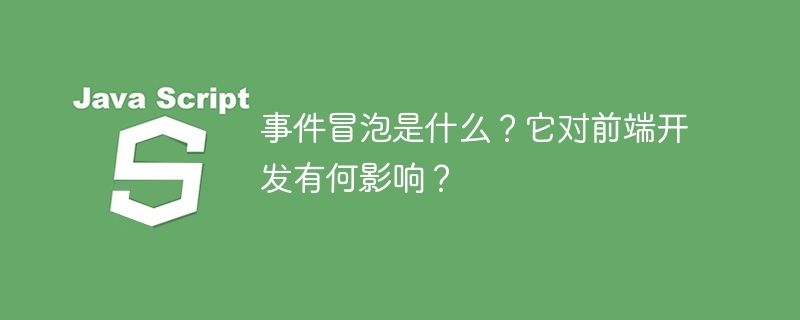Home >Web Front-end >JS Tutorial >Event bubbling mechanism and its impact in front-end development
Event bubbling mechanism and its impact in front-end development
- 王林Original
- 2024-01-13 15:46:14627browse

Event bubbling refers to the process in which after an event is triggered in the DOM, the event will be passed from the innermost element to the outer element. That is to say, when an element triggers an event, its parent element will also receive the event and execute the corresponding processing function. This event delivery process is like bubbles emerging from the bottom of the water, from the inside out, so it is called event bubbling.
Event bubbling has a great impact on front-end development. It allows developers to capture and handle events on parent elements without binding event handlers to each child element. This mechanism greatly simplifies the management and maintenance of events and makes code clearer and reusable.
The following uses a specific code example to illustrate the implementation and usage of event bubbling.
HTML part:
<div id="outer">
<div id="inner">
点击这里
</div>
</div>JavaScript part:
// 获取元素
var outer = document.getElementById('outer');
var inner = document.getElementById('inner');
// 绑定点击事件处理函数
outer.addEventListener('click', function(event) {
console.log('外层元素被点击');
});
inner.addEventListener('click', function(event) {
console.log('内层元素被点击');
});
// 点击inner元素(执行结果:内层元素被点击 -> 外层元素被点击)In the above code, there is an outer element and an inner element, respectively outer and inner represent. We bind click event handlers to both the outer element and the inner element. When the inner element is clicked, the event will bubble up to the outer layer along the DOM tree, thus triggering the click event handler on the outer element.
After actually running the code, we can see the output results on the console. The first output is "the inner element is clicked", and then "the outer element is clicked". This shows that the event bubbling mechanism causes click events on the inner elements to be passed to the outer elements in turn.
Through event bubbling, we can uniformly manage and process events on the parent element without binding event handling functions to each child element. This can greatly simplify the code and improve development efficiency. In addition, event bubbling can flexibly control the delivery and blocking of events to achieve more complex interactive effects.
In short, event bubbling is one of the very important mechanisms in front-end development. It simplifies the management and maintenance of events, improves the readability and maintainability of the code, and also provides developers with More ways to control and manipulate events.
The above is the detailed content of Event bubbling mechanism and its impact in front-end development. For more information, please follow other related articles on the PHP Chinese website!
Related articles
See more- Event capture, event bubbling and event delegation mechanism in Javascript
- A brief discussion on event bubbling, event delegation, and jQuery element node operations
- Is web front-end development difficult to learn?
- Will restoring the computer to factory settings have any impact on the computer?
- A brief discussion on event bubbling and event capturing in JavaScript

